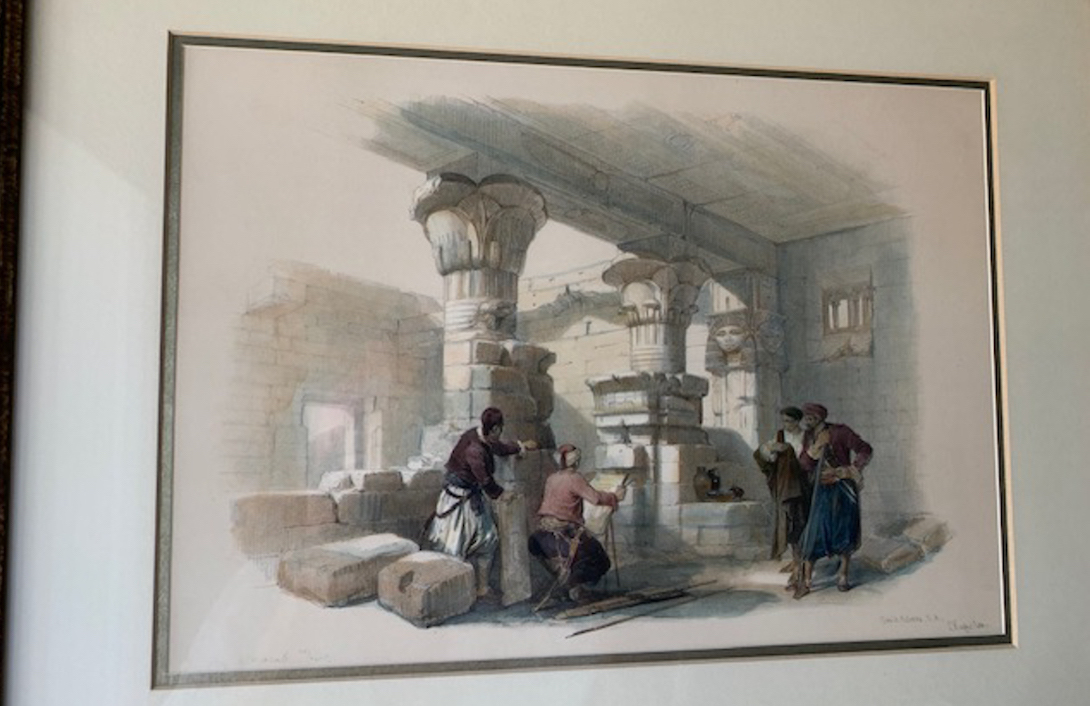The Lithographs of Scottish Artist David Roberts

A Montecito Journal reader has a series of works that are dear to my heart. This is a portfolio of early 19th-century foreign and European landscapes rendered in 50 plus lithographs by the Scottish artist David Roberts (Edinburgh, 1796-1864). I had a year abroad in grad school at the University of Edinburgh and met my future husband Adrian there; my future mother-in-law owned an eight-foot-long watercolor (original) of the skyline of Edinburgh by this artist, created in 1830s, hanging in her dining room in Roslin.
The artist David Roberts’ great friend Robert Scott Lauder painted a portrait of David Roberts in Arab dress that hangs in the National Portrait Gallery of Scotland. Why Arab dress? No European had been allowed to paint inside a mosque until the Scottish artist Roberts requested this honor in 1830; he was told that he could paint if he shaved off his muttonchop sideburns, if he left his hog-haired art brushes behind, and if he wore traditional Arab garb whilst painting. There’s a challenging aspect to Roberts’ works today as painted through the eyes of a European in a certain era. However, historically speaking, Roberts’ work was a herald of the new wave of interest in ‘exotic’ subjects, a sub-genre of Romanticism, works formerly termed Orientalism (a pejorative word today) in the early to mid-19th century. All across Europe, artists discovered the uniqueness of “the foreign” and instead of touring Europe for subject matter, they would take a solid year and travel far afield.
“Exotic” would not have described Roberts’ hometown! Grey and sooty and dark at 3 pm in the winter, Roberts’ city was “door and dreek” in the words of Sir Walter Scott. After Sir Walter died in 1832, Roberts was chosen to design four magnificent stained-glass windows for the 200-foot-tall Scott Monument in Princes Street Gardens; the Museum Room features Roberts’ St. Giles and St. Andrew, the coat of arms of Edinburgh, and Scotland. At the foot of the monument Roberts would have seen Sir Walter himself rendered in 30 tons of marble, with his hound Maida. Roberts contributed to the largest writer’s monument in the world.
David Roberts was born and raised in Edinburgh, Scotland’s capital city, the “Athens of the North,” and like the name implies, an 18th century and early 19th century city of Neoclassical architecture and philosophy. The city (and its scholars – think of economist David Hume; the University of Edinburgh has a famous building on campus called Hume Tower) was known for logic, finance, and engineering. Edinburgh’s art was different from any other art in the early 19th century; Edinburgh did not have a dedicated patron class of elites who commissioned art, as did the French and the English. So, when a Scottish artist painted, he painted scenes that the upper middle class, the wealthy merchant class, could appreciate, buy, and hang upon their walls. Roberts started painting in this way.
Roberts began his career as a painter of his city Edinburgh and the Highlands. Edinburgh in the late 18th and early 19th century was the center of a new Romantic landscape art which differed from the European style of Neoclassic realism of the Academies. When the era of Neoclassicism waned, the pendulum swung to the wildness of landscape painting, the freedom of brushstroke, and the expression of emotion in Scottish art. The Romantic landscape, composed of dramatic views, became Edinburgh’s contribution to art in the early 19th century; the museums and galleries in town grew. Like J.M.W. Turner’s work that Roberts had studied, Roberts’ Scottish landscapes were rendered in an almost dreamlike mystical form. He would bring this unique style to his paintings of foreign lands.
Scot artists travelled, as did Roberts. After Roberts painted Edinburgh and ‘romantic’ Scotland, he left for the Holy Land in 1838 to depict the architecture, people, and landscape. Roberts introduced the world to Syria and the Middle East through his art. Along with his friend George Croly’s descriptive words, Roberts published a portfolio: Views in the Holy Land, Syria, Idumea, Arabia, Egypt, and Nubia, published by F. G. Moon, 1846-9, one of the greatest travel works ever completed in a series of lithographs.
The images for the portfolio were completed in 11 months abroad; atmospheric images of sublime scenery, imposing architecture, and the picturesque rendered in tiny details.
Today’s market is not fond of his work, however. The value of a lithograph from this portfolio might sell at best for $500.






